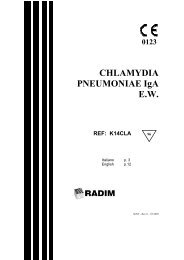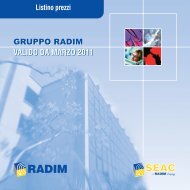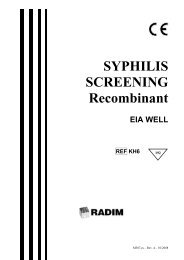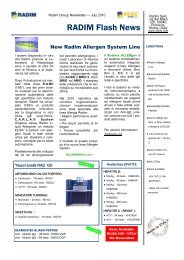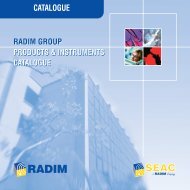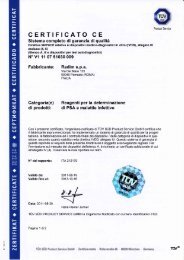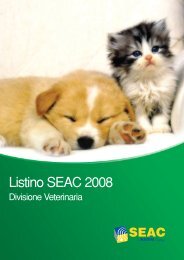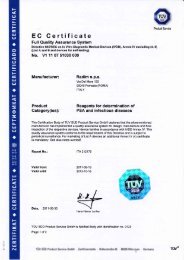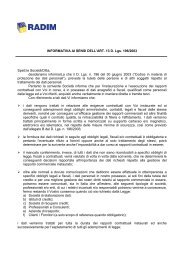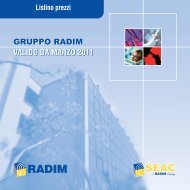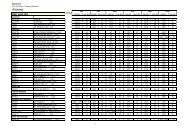CagA IgG EIA WELL REF K6HPG - Radim S.p.A.
CagA IgG EIA WELL REF K6HPG - Radim S.p.A.
CagA IgG EIA WELL REF K6HPG - Radim S.p.A.
You also want an ePaper? Increase the reach of your titles
YUMPU automatically turns print PDFs into web optimized ePapers that Google loves.
ENZYME IMMUNOASSAY FOR QUANTITATIVE DETERMINATION OF ANTI-<br />
<strong>CagA</strong> <strong>IgG</strong> ANTIBODIES IN HUMAN SERUM OR PLASMA.<br />
FOR IN VITRO DIAGNOSTIC USE ONLY<br />
1. CLINICAL APPLICATIONS<br />
Helicobacter pylori is a small, S-shaped gram-negative bacterium that infects the<br />
gastric mucosa in 20-80% of the human population. The prevalence of H. pylori<br />
infection increases with age and depends on several factors, such as geographic<br />
area and socioeconomic status. This bacterium causes chronic as well as acute<br />
gastritis, peptic ulcer disease, atrophic gastritis and it is suspected to have a role<br />
in gastric adenocarcinoma. H. pylori infection persists throughout lifetime, when<br />
not eradicated by specific antibiotic treatment. In patients with gastric or duodenal<br />
ulcers, H. pylori eradication results in a marked reduction of the recurrence rate.<br />
Nevertheless, although nearly all infected individuals develop gastritis, it remains<br />
unclear why most H. pylori-infected patients remain asymptomatic. In fact, it is<br />
only in a minority of these patients that the infection leads to gastric or duodenal<br />
ulcer. This may be due to several host factors (smoking, 0 blood type, male<br />
gender) and also to the heterogeneity among H. pylori strains. It has recently<br />
been discovered that approximately 50 to 60 % of H. pylori strains produce a 87<br />
kDa vacuolating cytotoxin (VacA) together with a highly antigenic protein of about<br />
120-128 kDa (<strong>CagA</strong>). On the other hand, strains that do not produce the cytotoxin<br />
do have the cytotoxin gene but lack the gene coding for <strong>CagA</strong>. Several studies<br />
have demonstrated that cytotoxin producing strains are isolated more frequently<br />
from subjects with peptic ulcer disease, rather than from subjects with non-ulcer<br />
dyspepsia. In serological studies, <strong>IgG</strong> against <strong>CagA</strong> have been detected in H.<br />
pylori-infected subjects with peptic ulcer disease much more recurrently than in<br />
infected individuals, with mere gastritis. Accordingly, the detection of anti-<strong>CagA</strong><br />
<strong>IgG</strong> in patient serum indicates previous infection by a <strong>CagA</strong>-positive H. pylori<br />
strain. This may be a helpful tool in therapeutical decisions.<br />
2. PRINCIPLE OF THE ASSAY<br />
This kit is based upon an enzyme immunoassay method (ELISA), where<br />
horseradish peroxidase is used as enzyme conjugate. During the first incubation,<br />
the sample anti-<strong>CagA</strong> <strong>IgG</strong> antibodies, if any, are bound to the <strong>CagA</strong> antigen<br />
coated wells. A wash cycle eliminates all unbound material. In the incubation that<br />
follows, a second antibody (anti-human <strong>IgG</strong> conjugated with peroxidase) will bind<br />
to the <strong>CagA</strong>-antigen-antibody complex. After a further wash cycle a colorless<br />
Chromogen solution (tetramethylbenzidine, TMB) in a substrate-buffer is added to<br />
the wells, where it yields a colored compound, by reacting with the peroxidase<br />
enzyme. Color development will be stopped by adding H2SO4. The color intensity,<br />
measured in a spectrophotometer at 450 and 405 nm, will thus be directly<br />
proportional to the anti-<strong>CagA</strong> <strong>IgG</strong> antibody concentration in calibrators and<br />
samples.<br />
<strong>K6HPG</strong> –<strong>CagA</strong> <strong>IgG</strong> <strong>EIA</strong> <strong>WELL</strong><br />
M197 – Rev.9 – 06/2008 – Pag. 12/ 24



